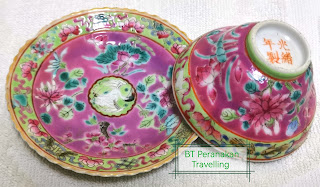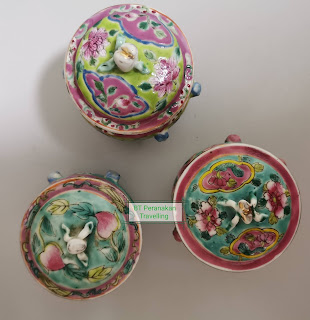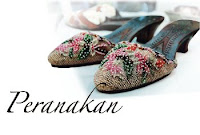如何探索峇峇娘惹文化 - "粉色内外娘惹陶瓷"
大家好, 谢谢大家浏览我的专栏。
如有什么意见,可以留下意见。我会在短期里回复你。
哈哈~对不起迟来的如何探索娘惹文化,这一集跟上几集有所不同,哪里不同呢?就是这集会大家了解峇峇娘惹内外粉色陶瓷的秘密"Haha~ Sorry for the belated introduction of how to explore Nyonya culture. This episode is different from the previous episodes. How is it different? This is the episode where everyone can learn about the secrets of in and out pink ceramics of the Baba Nyonya."
为什么会是峇峇娘惹内外粉色陶瓷的秘密 ?正所谓的内外就是陶瓷里外都有上彩了更多的颜色和图案, 同时内外粉色陶瓷也是很稀有~ 这些内外陶瓷都是来自富有的峇峇家族拥有。峇峇们都特地的回到中国江西里的景德镇找了位师傅为峇峇家族打造自己的陶瓷。峇峇们的要求的陶瓷都是手工制造,员工们是一手一手的画上去和烧出来细腻的陶瓷。 同时峇峇们都很喜欢颜色创辉,也要有蝴蝶或凤凰,和牡丹花,在峇峇娘惹文化里凤凰是代表了和祥,牡丹代表富贵。峇峇娘惹们都很注重好意头。同时内外粉色陶瓷都是由四季花为主. Why is it the secret of the in and out pink ceramics of the Baba Nyonya? The so-called in and out means that the inside and outside of the ceramics are painted with more colors and patterns. At the same time, the in and out pink ceramics are also very rare in market nowaday~ These in and out ceramics are owned by the wealthy Baba family. The Babas specially travel to Jingdezhen in Jiangxi, China to look for a master and order their own ceramics for the Baba family. The ceramics required by the Babas are all handmade, and the employees paint and bake the delicate ceramics hand by hand. At the same time, the Babas all like colors to create brilliance, and they also need butterflies, phoenixes, and peonies. In the Baba Nyonya culture, the phoenix represents peace and peony represents wealth. Baba Nyonyas are very focused on good intentions. At the same time, the in and out pink ceramics are mainly composed of four seasons flowers.
四季‘内和外‘陶瓷。什么是四季‘内和外‘陶瓷 ?四季 = 代表了四种不同的花,这四种花是来时不同季节的花,也是来在春兰, 夏荷, 秋菊, 冬梅。这代表了四季平安.同时‘内和外’陶瓷就是内有图案加上外也有图案。可是峇峇家族们都不会忘了八宝。娘惹瓷还有一大特征,就是在器物的内外口沿绘上绶带八宝,细致工巧,底色多是洋红或紫罗兰色。八宝或八吉祥经常与莲花一起搭配,组成缠枝莲花托八宝。所谓八宝,分别为法螺、法轮、宝伞、白盖、莲花、宝瓶、金鱼、盘长,又简称作轮、螺、幢、伞、花、瓶、鱼、结。八宝是佛教中流行的题材,特别是在藏传佛教中更为盛行。Four Seasons flowers ‘Inner and Outer’ ceramics. What are Four Seasons flowers design ‘inside and outside’ ceramics? Four seasons = represents four different flowers. These four flowers come in different seasons, and they also come in spring orchid, summer lotus, autumn chrysanthemum and winter plum. This represents the four seasons of peace. At the same time, the "inside and outside" ceramics have patterns on the inside and patterns on the outside. But the Baba family will never forget eight treasures. Another major feature of Nyonya porcelain is that the eight treasures of the ribbon are painted on the inner and outer edges of the utensils, which is meticulous and skillful. The background color is mostly magenta or violet. The eight treasures or eight auspicious symbols are often paired with lotus flowers to form a lotus flower holding the eight treasures. The so-called eight treasures are Dharma conch, Dharma wheel, precious umbrella, white cover, lotus, treasure vase, goldfish, and Panchang. They are also referred to as wheel, conch, building, umbrella, flower, vase, fish, and knot. The Eight Treasures are a popular theme in Buddhism, especially in Tibetan Buddhism.
看过了,我的照片和讲解。我相信你们应该懂的如何分辨了~哈哈哈~我们一起加油。如果想解更多关于峇峇娘惹文化,请可以发的问题在这里。
如有兴趣了解这些陶瓷。Check it out, my photos and explanation. I believe you should know how to tell the difference~ Hahaha~ Let’s work hard together. If you want to know more about Baba Nyonya culture, please post your questions here.
If you are interested in learning about these ceramics.




Comments
Post a Comment